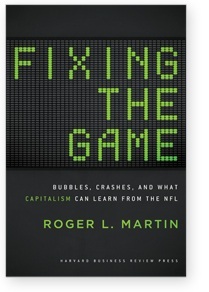Arriving a little late at the CFA Society Toronto luncheon on June 4, 2012 at the National Club on Bay Street, I had a lucky choice of seat at the “hodge podge” table near the back. My two nearest neighbours at the table had driven from Simcoe to Toronto that morning (a minimum two-hour trip) for the express purpose of meeting the featured speaker, Roger Martin, Dean of Rotman School of Management. One said he had not only read and enjoyed Martin’s latest book, Fixing the Game: Bubbles, Crashes, and What Capitalism Can Learn from the NFL, he had also bought several copies to give to friends. “You’ll enjoy the talk, even if you know very little about the NFL,” Bob assured me, and it turned out he was right.
I’d first come across Roger Martin as the author of the intriguing book The Opposable Mind, whose central thesis is that we as humans often hold two contradictory thoughts. At last, some theory to explain why I deplore celebrity culture yet still riffle through People magazine at the dentist’s.
Roger Martin began the presentation by declaring that the next financial crisis will definitely not be about sub-prime mortgages—any more than the next space mission problem will be about an O-ring that becomes brittle at low temperatures. It’s a case of “Thanks very much, but we’ve learned our respective lessons; disaster will come from a different source.”
Speaking of uncertain markets, on that particular late spring day in June, Martin said, “when facing a new crisis the first tendency is to think we did not clamp down enough in facing the old crisis—we knew the fix to the problem, only we didn’t apply it powerfully enough.”
The roots of the financial crisis of 2008, Martin posits, lie in a 1976 article, “The Theory of the Firm.” [Jensen, Michael C.; Meckling, William H. (1976). “Theory of the Firm: Managerial Behavior, Agency Costs and Ownership Structure,” Journal of Financial Economics 3 (4): 305–360. DOI:10.2139/ssrn.94043. SSRN 94043.] Jensen and Meckling argued that, to reduce misalignment between management and shareholders, executive compensation should be share-based. Their work was so convincing that, by year 2000, fifty percent of executive compensation packages had a stock-based component.
Martin said that, unfortunately, those who framed the packages did not realize the difference between the “real market” and the “expectations market.” The executives quickly figured out how to game the system. The most lucrative situation was to join the firm when expectations were low and the incoming executive would receive many stock grants at a low price. Then, the new executive should pump the expectations machine to the max so that the relative gain of stock options grew as large as possible. The latest crash, Martin says, was as big as it was because the expectations game was played better than ever before. Prior to the 1990’s, expectations were met 50 percent of the time; by the late 1990’s, expectations were beat a whopping 70 percent of the time.
Now, where does the NFL come in? Martin used it to explain two aspects of the financial world. Remember the New England Patriots of 2007? (I have to admit that even I, a complete NFL Dummkopf, have heard of the heartbreaking saga of the New England Patriots of ’07.) They went to the SuperBowl with a perfect 16-0 record (“real game”) but the bookies in Vegas calculating their odds gave them a mediocre 10-6 chance (“expectations game”).
NFL come in? Martin used it to explain two aspects of the financial world. Remember the New England Patriots of 2007? (I have to admit that even I, a complete NFL Dummkopf, have heard of the heartbreaking saga of the New England Patriots of ’07.) They went to the SuperBowl with a perfect 16-0 record (“real game”) but the bookies in Vegas calculating their odds gave them a mediocre 10-6 chance (“expectations game”).
The second, and more significant, NFL reference occurs when Martin explains what is wrong with Wall Street. The NFL handles the disjoin between the “real game” and the “expectations game” by forbidding those who play/coach/manage the game from making bets. It’s a complete ban—they are under threat of lifetime suspension. Contrast that with the business community, says Martin. Thanks to stock-based compensation, the executives are right in there, figuring out how to tinker with the “expectations market.” So much for removing the temptation to meddle.
Martin presented a cogent analysis and makes and excellent case for re-examining the rules of the (business) game. I’d say that’s worth a two-hour drive to hear his talk any day. ª
Postscript. Martin’s comment on earnings expectations resonates with a very recent article by Haigang Zhou and John Qi Zhu in the latest FAJ. [“Jump on the Post-Earnings Announcement Drift,” Financial Analysts Journal, Vol 68, No 3, p. 63]. The authors of that study looked at “a strategy that exploits the distinctive information in the … information-rich period of earnings announcements.” They studied the profitability of making assumptions on the post-earnings drift based on jump dynamics in stock prices around earnings announcements. They took long positions in positive-jump stocks and short positions in negative-jump stocks for 60 trading days starting two days after earnings announcements. Their hedge portfolio had a quarterly return of 3.63% (annualized return of 15.3%) and an annualized Sharpe ratio of 1.52 over the four decades 1971-2009. Not too shabby for a theory based on the “expectations market.” ª
Roger Martin’s web site can be found at: http://rogerlmartin.com/
Fixing the Game, the book his talk is based on can be found at: http://rogerlmartin.com/library/books/fixing-the-game/

